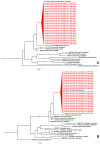The Prevalence of Bartonella Bacteria in Cattle Lice Collected from Three Provinces of Thailand
- PMID: 31142009
- PMCID: PMC6628184
- DOI: 10.3390/insects10060152
The Prevalence of Bartonella Bacteria in Cattle Lice Collected from Three Provinces of Thailand
Abstract
Cattle lice are obligatory blood-sucking parasites, which is the cause of animal health problems worldwide. Recently, several studies have revealed that pathogenic bacteria could be found in cattle lice, and it can act as a potential vector for transmitting louse-borne diseases. However, the cattle lice and their pathogenic bacteria in Thailand have never been evaluated. In the present study, we aim to determine the presence of bacterial pathogens in cattle lice collected from three localities of Thailand. Total genomic DNA was extracted from 109 cattle louse samples and the Polymerase Chain Reaction (PCR) of 18S rRNA was developed to identify the cattle louse. Moreover, PCR was used for screening Bartonella spp., Acinetobacter spp., and Rickettsia spp. in cattle louse samples. The positive PCR products were cloned and sequenced. The phylogenetic tree based on the partial 18S rRNA sequences demonstrated that cattle lice species in this study are classified into two groups according to reference sequences; Haematopinus quadripertusus and Haematopinus spp. closely related to H. tuberculatus. The pathogen detection revealed that Bartonella spp. DNA of gltA and rpoB were detected in 25 of 109 samples (22.93%) both egg and adult stages, whereas Acinetobacter spp. and Rickettsia spp. were not detected in all cattle lice DNA samples. The gltA and rpoB sequences showed that the Bartonella spp. DNA was found in both H. quadripertusus and Haematopinus spp. closely related to H. tuberculatus. This study is the first report of the Bartonella spp. detected in cattle lice from Thailand. The finding obtained from this study could be used to determine whether the cattle lice can serve as a potential vector to transmit these pathogenic bacteria among cattle and may affect animal to human health.
Keywords: 18S rRNA; Bartonella spp.; Thailand; cattle louse; gltA; rpoB.
Conflict of interest statement
The authors declare no conflict of interest.
Figures


Similar articles
-
Identification of different Bartonella species in the cattle tail louse (Haematopinus quadripertusus) and in cattle blood.Appl Environ Microbiol. 2014 Sep;80(17):5477-83. doi: 10.1128/AEM.01409-14. Epub 2014 Jun 27. Appl Environ Microbiol. 2014. PMID: 24973066 Free PMC article.
-
Molecular survey of the head louse Pediculus humanus capitis in Thailand and its potential role for transmitting Acinetobacter spp.Parasit Vectors. 2015 Feb 26;8:127. doi: 10.1186/s13071-015-0742-4. Parasit Vectors. 2015. PMID: 25889008 Free PMC article.
-
Molecular detection and genetic diversity of Bartonella species in large ruminants and associated ectoparasites from the Brazilian Cerrado.Transbound Emerg Dis. 2020 Sep;67(5):1888-1897. doi: 10.1111/tbed.13517. Epub 2020 Mar 10. Transbound Emerg Dis. 2020. PMID: 32068964
-
[Lice and lice-borne diseases in humans].Med Trop (Mars). 2005;65(1):13-23. Med Trop (Mars). 2005. PMID: 15903070 Review. French.
-
Human pathogens in body and head lice.Emerg Infect Dis. 2002 Dec;8(12):1515-8. doi: 10.3201/eid0812.020111. Emerg Infect Dis. 2002. PMID: 12498677 Free PMC article. Review.
Cited by
-
Cave-dwelling phlebotomine sand flies (Diptera: Psychodidae: Phlebotominae) in Thailand: population composition and pathogen detection of Bartonella and Trypanosoma.Parasit Vectors. 2024 Dec 19;17(1):523. doi: 10.1186/s13071-024-06616-8. Parasit Vectors. 2024. PMID: 39702493 Free PMC article.
-
First record of natural infection with Anaplasma marginale in sucking lice infesting the water buffalo (Bubalus bubalis) in Mexico.Parasitol Res. 2020 Nov;119(11):3853-3856. doi: 10.1007/s00436-020-06772-7. Epub 2020 Jun 25. Parasitol Res. 2020. PMID: 32588174
-
Prevalence and Molecular Characterization of Parasitic Lice in Tibetan Yaks, Pigs and Sheep.Life (Basel). 2025 Mar 12;15(3):444. doi: 10.3390/life15030444. Life (Basel). 2025. PMID: 40141788 Free PMC article.
-
The first report of the seroprevalence of antibodies against Bartonella spp. in water buffaloes (Bubalus bubalis) from South Thailand.Vet World. 2021 Dec;14(12):3144-3148. doi: 10.14202/vetworld.2021.3144-3148. Epub 2021 Dec 24. Vet World. 2021. PMID: 35153405 Free PMC article.
References
-
- Kumsa B., Bekele S. Lice Infestation on Cattle in Endegagn District, Southern Ethiopia: Species Composition, Prevalence and Seasonal Pattern. Bull. Anim. Health Prod. Afr. 2008;56:213–222. doi: 10.4314/bahpa.v56i3.43285. - DOI
-
- Durden L.A., Loyd J.E. Lice (Phthiraptera) In: Mullen G.R., Durden L.A., editors. Medical and Veterinary Entomology. 2nd ed. Academic Press Ltd.; London, UK: 2009. pp. 59–82.
-
- Taylor M.A., Coop R.L., Wall R.L. Parasites of horses. In: Taylor M.A., Coop R.L., Wall R.L., editors. Veterinary Parasitology. 3rd ed. Blackwell Publishing; Oxford, UK: 2007. pp. 259–315.
-
- Sangvaranond A. Studies on lice of domesticated cattle and buffaloes in Thailand. J. Thai. Vet. Med. Assoc. 1988;39:165–174.
LinkOut - more resources
Full Text Sources
Miscellaneous

